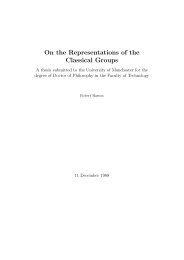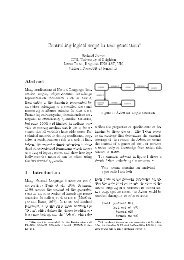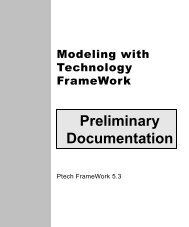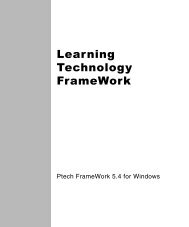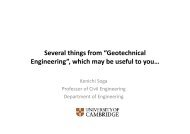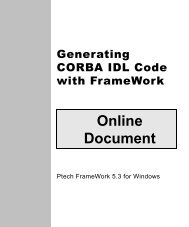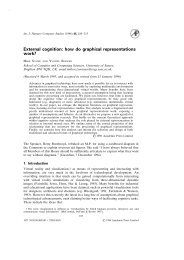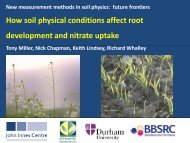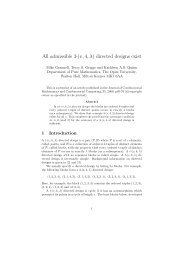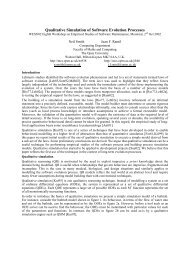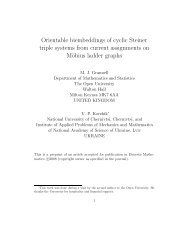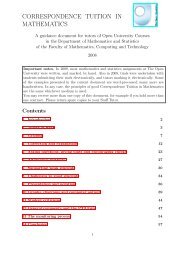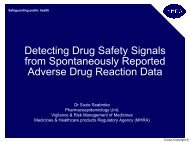Can mobile devices facilitate more integrated learning?
Can mobile devices facilitate more integrated learning?
Can mobile devices facilitate more integrated learning?
You also want an ePaper? Increase the reach of your titles
YUMPU automatically turns print PDFs into web optimized ePapers that Google loves.
<strong>Can</strong> <strong>mobile</strong> <strong>devices</strong> <strong>facilitate</strong> <strong>more</strong><br />
<strong>integrated</strong> <strong>learning</strong>?<br />
Yvonne Rogers<br />
Pervasive Interaction Lab<br />
Open University
Popular claims about <strong>mobile</strong> <strong>learning</strong><br />
• Convenience<br />
– any place any time, e.g., walking, eating,<br />
waiting, cycling<br />
• Context<br />
– have ready access to web and other<br />
information resources, e.g., podcasting<br />
when at museums, historical sites, etc.<br />
• Motivation<br />
– increases engagement and improves <strong>learning</strong>,<br />
e.g., writing, note-taking, organizing
<strong>Can</strong> <strong>mobile</strong> <strong>learning</strong> be <strong>more</strong>?<br />
• Facilitate moving between different <strong>learning</strong> spaces,<br />
e.g., private and public<br />
• Facilitate conversations across context<br />
– “coming to know through continuous conversations across multiple<br />
contexts amongst people and interactive technologies” (Sharples<br />
et al, 2007)<br />
• Facilitate <strong>integrated</strong> <strong>learning</strong><br />
– reflecting on ongoing activities<br />
– switching between observation and analysis<br />
– taking the initiative what to do next<br />
• Our focus: scientific inquiry processes
Typical model of scientific inquiry<br />
• Abstract knowledge taught in the classroom poorly<br />
<strong>integrated</strong> with concrete experiences in the field<br />
– Follows a linear model<br />
– Inquiry activities performed separately<br />
– Collation, analysis and reasoning about data collected<br />
in the field delayed until back in classroom<br />
– PC software is largely procedure-based<br />
– Students rarely take responsibility for their inquiries<br />
• Curtails opportunities for students to analyze<br />
and reflect on their feet when make discoveries<br />
Experiment Goals<br />
in Classroom<br />
Data Collection<br />
in field<br />
Data Analysis<br />
in lab<br />
Conclusion<br />
in classroom
An alternative approach<br />
• Encourage students to:<br />
– Observe and think<br />
– Connect, reflect and explain<br />
the real with the represented<br />
– Formulate own researchable<br />
questions<br />
– Interpret and compare own and<br />
other’s data<br />
– Communicate results to others
Sense-making<br />
• Social construction of knowledge (Schoenfield, 1992)<br />
– switching between abstractions<br />
– <strong>learning</strong> to think like a scientist<br />
• Conversations and dialogic struggles students engage in<br />
– making connections between digital representations (e.g. graph, tables)<br />
and scientific phenomena (e.g. global warming)<br />
• Mobile technologies can support sense-making<br />
– enable conversations across context<br />
– provide contextually-relevant information and pertinent data
First steps: Ambient Wood<br />
• Part of a large EPSRC IRC collaboration - Equator<br />
(2000-2006)<br />
– involving partners and schools from Nottingham, Bristol, Sussex,<br />
RCA and Southampton<br />
• Designing a fieldtrip with a difference<br />
– encourage children to explore and hypothesize about a woodland<br />
while collecting own data<br />
– reflect upon data collected in the physical environment<br />
• Diversity of <strong>mobile</strong> <strong>devices</strong> and visualization tools<br />
were designed<br />
– provided access to contextually-relevant digital information
Interactive <strong>devices</strong> and tools<br />
Probing <strong>devices</strong><br />
Listening <strong>devices</strong><br />
Viewing <strong>devices</strong><br />
Visualizing tools<br />
Analyzing tools<br />
Communication<br />
tools
Role of <strong>devices</strong> and digital<br />
– focus and provoke<br />
• make the invisible<br />
visible<br />
• make the far near<br />
• make the inaudible<br />
audible<br />
augmentation<br />
• make the past present
An example: Probing tool with<br />
dynamic visualization<br />
• Combined hand-crafted<br />
probing tool and PDA<br />
display<br />
Immediate feedback showing<br />
relative levels of moisture<br />
and light
• Predicting moisture<br />
levels for different<br />
parts of the clearing<br />
• Self-initiated, creative<br />
and collaborative<br />
<strong>learning</strong> activity<br />
Probing in action
Collaborative reasoning<br />
Girl 2 probes ground<br />
Girl 1 looks at reading on PDA: Yeah, it<br />
is much higher[<br />
Girl 2: Oh yeah, right, so it is much<br />
wetter<br />
Girl 2 walks off to tree: shall we try a<br />
leaf?<br />
Girl 1 stays put: Do it, do, do, do, do it<br />
here again so we can see<br />
Girl 2 returns and probes where asked<br />
Girl 1: It is exactly the same, so<br />
Girl 2: That’s right, because they’re the<br />
same…<br />
Girl 1: yeah, they’re the same<br />
Girl 2 leads girl 1 to tree<br />
Girl 2: How about we try a dry leaf?
Reflecting,<br />
comparing and<br />
hypothesizing<br />
• Pairs of children came<br />
together and shared<br />
experiences in ’den’<br />
• Unaware that their probe<br />
readings had been tracked<br />
• Fascinated by visualizations<br />
of the different sets of data<br />
• Much predicting of each of<br />
their readings before<br />
interacting with the data
Next steps: Lilly Arbor project<br />
• Ongoing environmental restoration project at<br />
Indiana University where scientists and students<br />
collaborate<br />
– Measuring changes to environment (e.g., trees, water quality)<br />
– Conduct experiments to assess best way of restoring riverbanks
Comparing different tree planting<br />
methods for floodplains<br />
– Containerized trees in a row<br />
– Bare root seedlings in a row<br />
– Bare root seedlings random
Paper-based approach to measuring<br />
• Teams measure tree growth twice a year<br />
– 3-4 students, a corporate volunteer and scientist<br />
• Each team provided with measuring<br />
<strong>devices</strong>, a map and paper check-list<br />
– Need to first locate a tree, identify it and take<br />
measurements<br />
– Then record and add comments
LillyPad<br />
• Paper-based method not optimal for <strong>learning</strong><br />
– OK for recording measurements but poor for supporting<br />
analysis<br />
• Proposed a <strong>mobile</strong> <strong>learning</strong> device<br />
– Enable students to readily switch between observation, data<br />
collection and analysis<br />
– Enter new measurements electronically and be able to<br />
compare with previous measurements<br />
– Have access to information to help identification and<br />
explanation
Goals<br />
• Learning goals<br />
– Use digital information to understand <strong>more</strong> about<br />
observations<br />
– Share and discuss observations with each other<br />
– Reflect on discoveries when measuring<br />
• Usability goals<br />
– Enter measurements and look up data quickly<br />
– Rapid <strong>learning</strong> of functionality<br />
– Use continuously for 6-8 hours
Screenshots of Lillypad<br />
Data entry pages<br />
Info and stats pages
The first in-situ study<br />
• 6 teams of 3-4 students and 1-2 volunteers<br />
• Each team given a PDA<br />
• Training took place in situ
Evaluating LillyPad device<br />
• Collected a mix of data:<br />
– Logs of page clicks on PDAs<br />
– Focus group at end with team leaders<br />
– Student running commentary<br />
– Video data for each group
What happened?<br />
• Did not meet our <strong>learning</strong> or usability goals<br />
– Data entry was successful but cumbersome<br />
– Entering comments was extensive but tedious<br />
– Information and stats pages used only occasionally<br />
• Very little reflection about the state of the<br />
restoration site
Visualization of task-related and sense-making activities<br />
Q1<br />
S3: “So we want to figure out when it died?”<br />
PDA: “Once dead, now alive?”<br />
T: “Go ahead and accept that and then look at the stats page.<br />
Dead dead dead dead dead dead dead dead our every measurement”<br />
S2 “Wow it has been dead?”<br />
S3: We got a comeback. It is…”
What were the problems?<br />
• Task switching or task interruption?<br />
• Task overload for person holding the device<br />
causing bottleneck?<br />
• Tension between completing the measuring<br />
task and reasoning about anomalies?<br />
• Device too fiddly?<br />
• Environment not conducive?
Are we asking too much?<br />
• <strong>Can</strong> students switch between task and sensemaking<br />
activities?<br />
– different perspectives and representations?<br />
• Does this lead to <strong>more</strong> <strong>integrated</strong> <strong>learning</strong>?
Led to major redesign of LillyPad<br />
• Revisit our <strong>learning</strong> and usability goals<br />
– <strong>more</strong> proactive use of device<br />
– integrate data collection and analysis activities<br />
• Reduce cognitive load<br />
– Enhance interface elements<br />
– Provide two PDAs per team<br />
• Provide <strong>more</strong> task-relevant information<br />
• Include graphical representations to support sensmaking<br />
• Increase awareness across groups<br />
– Enable comparisons of measurements via text messaging between remote<br />
groups
Old and new info page
Example of task relevant pages
Graph function
Message function
But had we overdone it?<br />
• Too many functions now?<br />
• Was it harder to learn?<br />
• Was the interface too complex to use in situ?<br />
• Would the multiple changes <strong>facilitate</strong> <strong>more</strong><br />
analysis and reflection?
Main findings from 2nd in-situ study<br />
• More engagement<br />
– Info and stats pages frequently used to help in process of identifying trees<br />
– Team leaders tailored questions that could be answered by looking up<br />
relevant information on the device that led to discussion<br />
• More analysis<br />
– The graphing function used to reason and make hypotheses about<br />
anomalies (e.g. why a tree seemed to have shrunk)<br />
– More instances (15-25 per group) of working out cause of growth rate<br />
(local, species, method)<br />
• More sharing<br />
– ‘Over the shoulder’ showing and looking at images, data, and graphs<br />
– Lots of reading out aloud history details and information
Mean number of page clicks for<br />
version I and II of LillyPad
Vignette of <strong>integrated</strong> sense-making<br />
• An anomalous observation triggered an extensive<br />
and distributed chain of reasoning<br />
– Why a tree appears to have shrunk<br />
• Members fluidly switch between their observations<br />
of the physical environment and the different<br />
representations on the PDA<br />
• Large number of hypothesis and interpretations<br />
made<br />
• Contest each other’s suggestions using the graphs to<br />
support their claims
Visualizations of sense-making and task-related activities
Visualizations of sense-making and task related activities
But the students did not want to text…<br />
• Messaging facility<br />
used only<br />
occasionally<br />
• Local ongoing activities<br />
too fast paced<br />
• Too distracting<br />
10:57:52 | Area6 | bindweeds are dead<br />
11:36:14 | Area7 | hi<br />
11:41:12 | Area8 | we r seeing catalpzs in the trees<br />
11:41:40 | Area8 | our bindweeds r dead as well<br />
11:46:29 | Area6 | bindweed dead<br />
11:48:13 | Area6 | catepillers<br />
11:49:15 | Area6 | did you mean catepillers<br />
12:00:13 | Area8 | we have a seedling cottonwood, Lenore is very excited!<br />
12:02:55 | Area8 | on what are the catterpillers? and what kind?<br />
12:13:41 | Area7 | is lunch ready<br />
12:21:34 | Area7 | lunch is ready come get it<br />
13:51:49 | Area6 | W hat tree are you on?<br />
13:57:34 | Area8 | 8096<br />
“You know I don’t want to mess with messages. I want to be out<br />
here. I don’t want to miss anything.”
Is this <strong>integrated</strong> <strong>learning</strong>?<br />
• Much evidence of using data, graphs and<br />
info in combination with locating, measuring<br />
and recording<br />
– identify trees and reason about their growth patterns<br />
• LillyPad II supported switching between<br />
observations and sense-making<br />
• Sometimes the students initiated questioning<br />
• Collaborative sense-making<br />
– through sharing and showing of data and representations
Conclusions<br />
• Many opportunities for augmenting <strong>learning</strong><br />
using <strong>mobile</strong> technologies<br />
– <strong>Can</strong> result in task overload<br />
– <strong>Can</strong> <strong>facilitate</strong> switching between physical observations,<br />
abstractions used in science and contextual information<br />
– Enable students to generate questions based on what they<br />
discover in the physical world with ‘at hand’ data<br />
– Encourages team leaders to ask different kinds of<br />
questions leading to discussions
Acknowledgements<br />
• Collaborators on the Lilly Arbor project:<br />
– Kay Connelly, Lenore Tedesco, Polly Baker, Bob Hall, Kara Salazar,<br />
Richie Hazlewood, Andy Kurtz, Tammy, Toscos, Josh Hursley<br />
– Team leaders, service <strong>learning</strong> students and Lilly volunteers<br />
• Collaborators on the Ambient Wood project:<br />
– Mike Scaife (in memoriam), Sara Price, Eric Harris, Hilary Smith,<br />
Cliff Randell, Henk Muller, Claire O’ Malley, Danae Fraser Stanton,<br />
Mark Thompson, Mark Weal, Ted Phelps, Danielle Wilde, Mia<br />
Underwood, Paul Marshall, Rowanne Fleck<br />
• Funding:<br />
– Lilly Foundation, Pervasive Technology Labs, Indiana University<br />
– EPSRC Equator IRC
Spring<br />
Trees easy to find but hard to identify<br />
Autumn<br />
Trees hard to find but easy to identify



